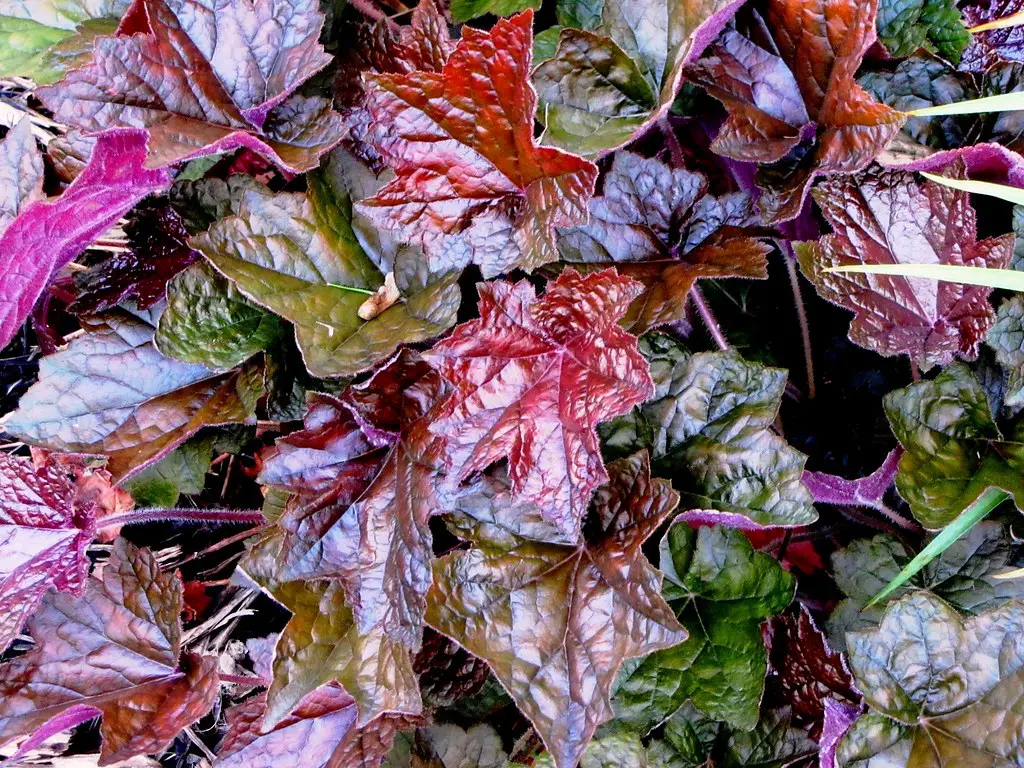Coral Bells, scientifically known as Heuchera, is a versatile and attractive perennial plant known for its vibrant foliage and delicate flowers. Belonging to the Saxifragaceae family, Coral Bells are native to North America and grow in a variety of vibrant shades, including red, orange, purple, green, and silver. They are appreciated for their mounded growth habit and broad leaves, which add texture and color to gardens and landscapes.
The plant’s name, Coral Bells, comes from its dainty bell-shaped flowers that bloom on slender stalks above the foliage, resembling coral structures. These flowers not only add aesthetic value but also attract hummingbirds, bees, and butterflies, making the plant a great addition to pollinator gardens.
In addition to their decorative features, Coral Bells are loved by gardeners for their adaptability and ease of care. They can thrive in various climates and soil types, making them suitable for gardeners ranging from beginners to seasoned experts. Their compact size also makes them an excellent choice for container gardening, rock gardens, and as ground cover or edging plants.
| Attribute | Details |
|---|---|
| Common Names | Coral Bells, Heuchera |
| Botanical Name | Heuchera |
| Family | Saxifragaceae |
| Plant Type | Perennial |
| Mature Size | 12-36 inches |
| Sun Exposure | Full sun to partial shade |
| Soil Type | Well-drained, rich soil |
| Hardiness Zones | 4-9 |
| Native Area | North America |
Coral Bells Care
Coral Bells are relatively low-maintenance plants that offer year-round visual interest. They prefer well-drained, rich soil and benefit from a location with full sun to partial shade, depending on the specific variety and climate. In hotter regions, some afternoon shade is usually beneficial.
Watering should be consistent, especially during the growing season. Overly wet soil can lead to root rot, so it’s essential to ensure proper drainage. Fertilizing is generally not required but can promote more vigorous growth and richer coloration.
Light Requirement for Coral Bells
Coral Bells thrive best in full sun to partial shade. In hotter climates, afternoon shade can prevent leaf scorching and preserve the vibrant leaf colors. In cooler climates, more sun can lead to more robust growth and richer foliage coloration.
Soil Requirements for Coral Bells
Coral Bells prefer well-drained, rich soil with organic matter. The soil pH should ideally be neutral to slightly acidic. Heavy clay or overly sandy soils should be amended with organic material to provide the right structure and nutrients.
Water Requirements for Coral Bells
Coral Bells need consistent watering, especially during their first growing season. Once established, they are moderately drought-tolerant but benefit from regular watering during prolonged dry periods.
Temperature and Humidity
Coral Bells are hardy plants that can withstand varying temperature conditions. They perform well in USDA hardiness zones 4-9. Humidity is generally not a concern for Coral Bells, but proper spacing and good airflow help prevent potential fungal problems.
Fertilizer
While Coral Bells are not heavy feeders, a balanced slow-release fertilizer applied in the early spring can enhance growth and foliage color.
Pruning Coral Bells
Pruning is not usually required but can be performed to remove dead or damaged leaves and spent flower stalks. Doing so will keep the plant looking tidy and encourage new growth.
Propagating Coral Bells
Coral Bells can be propagated through division in the spring or fall. Divide the clump into smaller sections, ensuring each has some healthy roots, and replant.
How To Grow Coral Bells From Seed
Growing Coral Bells from seed can be a slow process. Seeds can be started indoors in late winter or directly sown in the garden in spring. They should be lightly covered with soil and kept moist.
Common Pests & Plant Diseases
Aphids
Aphids can be controlled with insecticidal soap or natural predators.
Downy Mildew
Avoid overwatering and ensure proper spacing to prevent Downy Mildew.
Rust
Rust can be treated with fungicides and by removing infected leaves.
Common Problems With Coral Bells
Leaf Scorch
Hot sun without adequate shade can lead to leaf scorch. Provide shade during hot afternoons.
Root Rot
Overwatering and poor drainage can cause root rot. Ensure proper watering practices and well-drained soil.
Pro Tips
- Choose the right Coral Bells variety for your specific climate and garden conditions.
- Plant in groups for a more dramatic effect in garden borders or rock gardens.
- Use Coral Bells in container gardens for added color and texture.
- Pair with other shade-loving plants like hostas or ferns for a cohesive woodland garden look.
- Monitor regularly for pests and diseases, and take prompt action as needed to maintain plant health.




